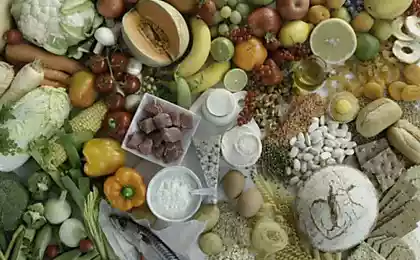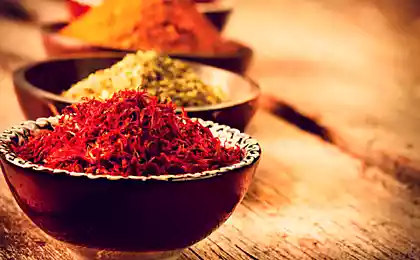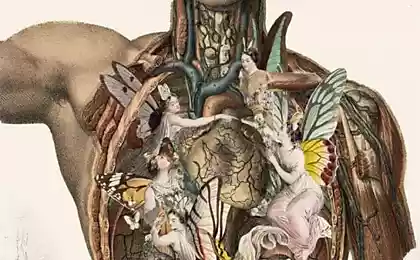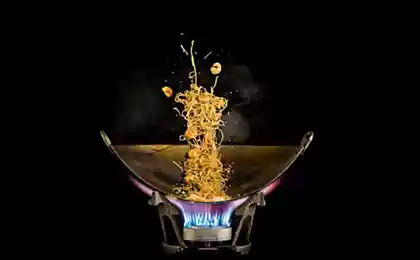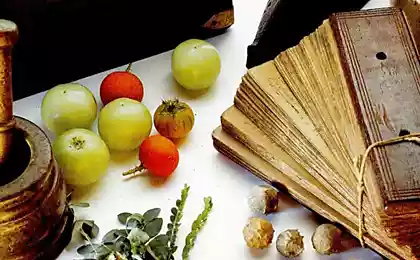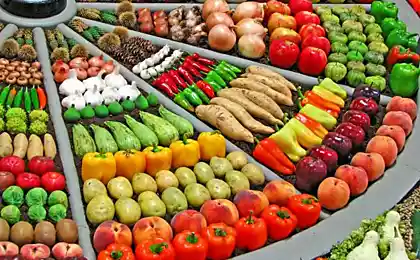2840
Egyptian Cuisine
Halva
Halva - Middle Eastern food, common in all the countries in the Mediterranean. Made from sesame seeds and is available in many forms: blocks, cakes, energy bars, etc. Halva is sometimes mixed with other additives to enhance the flavor. Among them: pistachios, pine nuts and almonds. Egyptians eat halva, as a snack or for breakfast and lunch. It can be used as the main component in many other dishes, such as Salakan - a mixture of halva, honey and whipped cream. It is also one of the few products that can withstand the hot Egyptian weather without decomposition, without needing any special storage conditions.
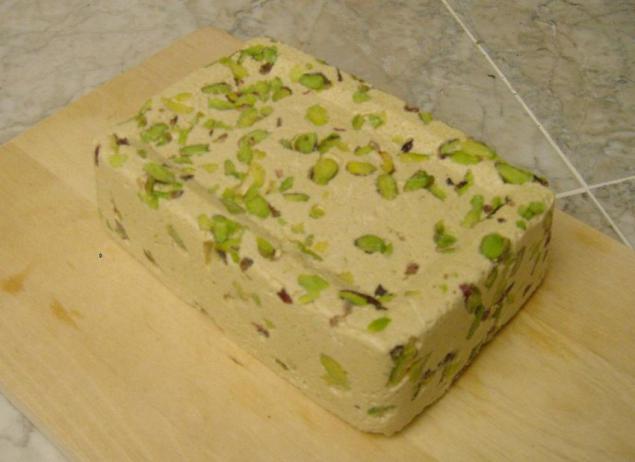
Kushari
Believes the Egyptian national dish, Kushari including rice, pasta, lentils, onions, garlic and chickpeas. The presence of four sources of carbohydrates makes it the most popular dish for lunch in most regions of Egypt for over 100 years. Interestingly, the origin Kushari not Egyptian. In fact, this dish dish was imported by the British army in the 19th century: the pasta was imported from Italy, tomatoes from Latin America and rice from Asia, but the idea is to mix it all together in one extremely delicious vegetarian dishes was conceived in Egypt. Kushari has become an integral part of the national cuisine of Egypt ever since.
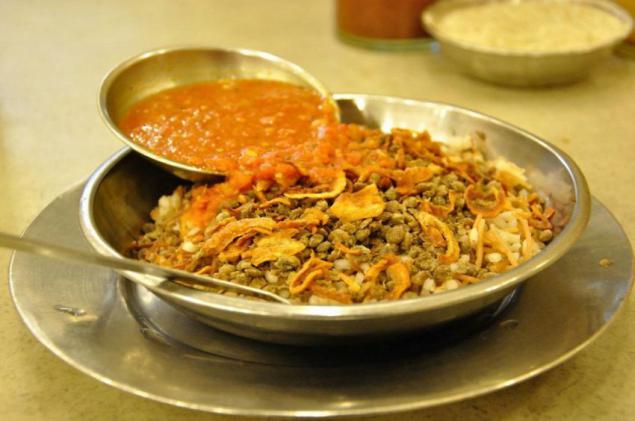
Ful medames
One of the most popular dishes in Egypt, Ful medames consists of beans, served with butter, garlic and lemon juice. Ful medames can be traced back to Pharaonic roots and references were found in the twelfth dynasty. The word "Medames" has Coptic origin and translates as "buried." This relates to the way the original dish prepared: in pot buried in the hot charcoal or sand. Ful medames can be supplied with a number of additives such as oil, tomato sauce, tahini or egg. However, most traditional method - eat it just salt, with Egyptian bread bun. Nowadays it is national dishes of Egypt exported to many Middle Eastern countries such as Syria, Lebanon, Saudi Arabia and Sudan.
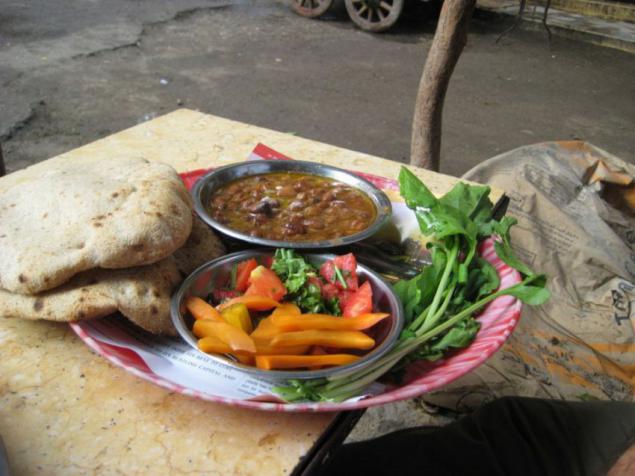
Fatta
Regarded as Nubian dish Fatta usually prepared for celebrations, such as the first born of women, Christian and Muslim holidays. The dish consists of layers of rice and fried bread coated with garlic cloves and vinegar. Large chunks of stewed beef and deep-fried, poached eggs are usually served along with the basis of rice and bread. As you can imagine, Fatta - really rich dish with a very high calorie. His rarely eat during the year, except for major religious days, 50 days before Easter in the Coptic Christians, or in the month of Ramadan.
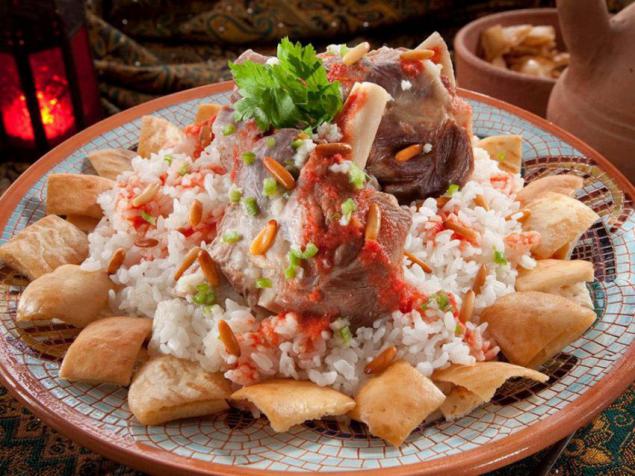
Muluk
Muluk prepared from the leaves of jute and other plants that grow in the eastern and northern Africa. In Egypt muluk prepared from chopped leaves with garlic and coriander, with the addition of meat of chicken, beef, or a rabbit, and served with Egyptian bread or rice. Interestingly, various cities in Egypt are preparing the dish in different ways, for example - as the base for the broth in coastal cities such as Alexandria and Port Said, used seafood. During the end of the tenth century, the dish was banned Fatimid caliph Al-Hakim bi-Amr Allah. After the ban was lifted, some religious sects still refuse to eat the dish in respect to the late Caliph.
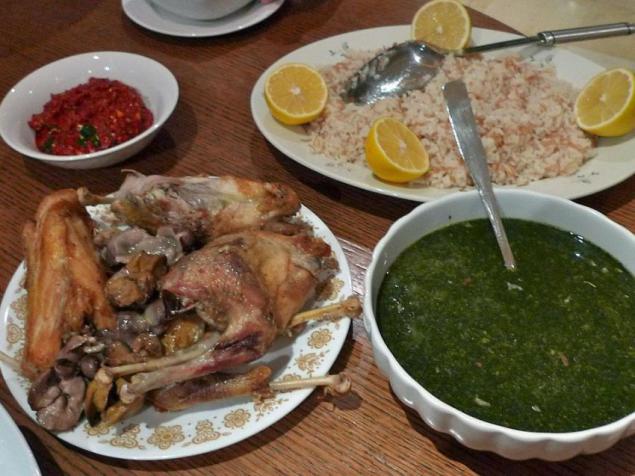
Fisikh
Fisikh (Feseekh) - a traditional Egyptian dish is served only during the festival of Sham El Nessim - spring celebration with Pharaonic origin. He is a gutted, salted and dried gray mullet. The preparation process includes drying fish in the sun and salt, the dish is usually prepared Fasahani specialized person. Because of the method of preparation Fisikh can cause poisoning if cooked properly. Fish is usually stored in thick glass jars, which firmly closed as exude a very pungent odor. The dish is served with Egyptian bread, cut into cubes, onions and lots of lemons.
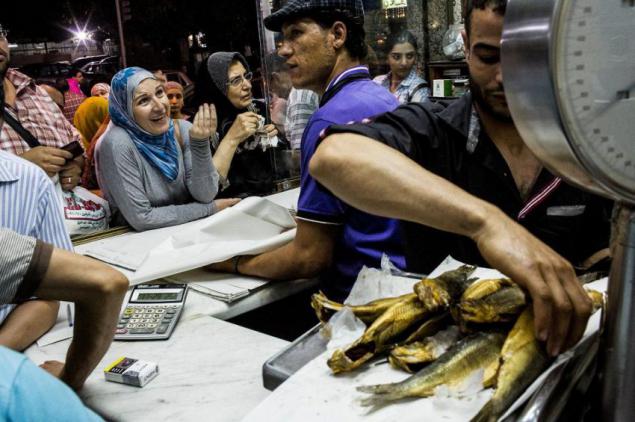
Taro Soup
Taro - native plant of Southeast Asia, which appeared in the Mediterranean part of Egypt in ancient times. Taro soup is very popular in Egypt, and the cooking process includes cleaning taro tubers and their boiling broth with lemon juice, garlic and coriander. Once out of mashed taro, and served as a side dish with Egyptian flat bread. Taro is prepared during the Coptic Christian celebrations of Baptism and the cooking method resembles the baptism of Jesus.
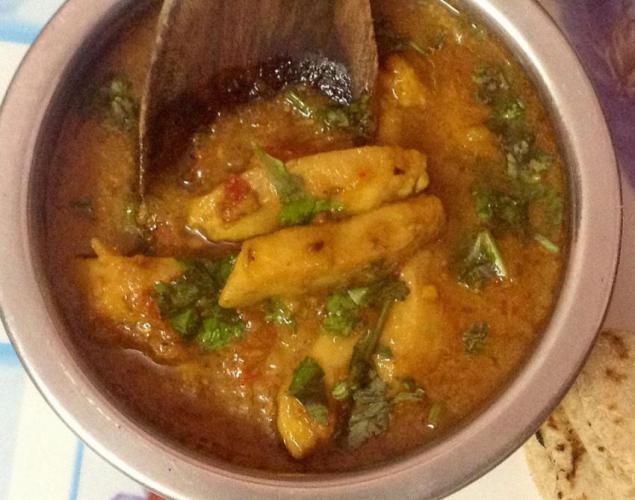
Dukka
Dukka - Egyptian food, commonly used as an appetizer or side dish, along with Egyptian flat bread, or raw vegetables. This dish is a national Egyptian cuisine consists of a mixture of herbs, nuts and spices, such as salt, sesame, coriander and cumin. Dukka usually prepared at home, and every family has different additives to the recipe. It is also sold in stores spices in small paper cones. The name "Dukkah" obtained is of Arabic origin and describes how all the spices mixed together to prepare a dish. Little known outside of Egypt, received only a small popularity in Australia. But among the most popular street food world is the Egyptian falafel, widespread throughout the world.
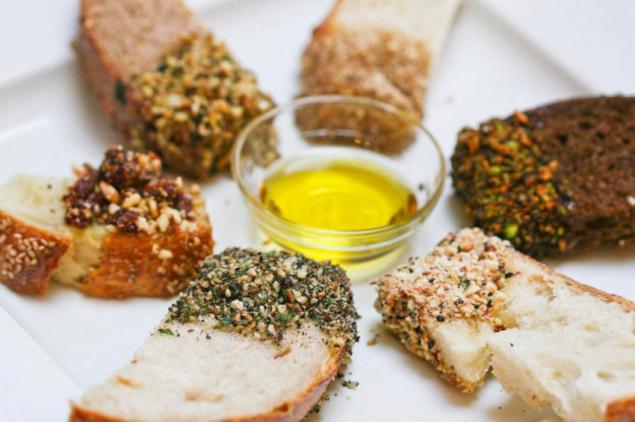
Kunafa
Kunafa - Egyptian delicacy, made of very thin, like noodles biscuits. Origin kunafy very mysterious - his presence was recorded in medieval Arab cookbooks Egypt, the Levant and Turkey, but the exact origin has always been known. Refreshments prepared by spraying with long rows of liquid noodles on a hot plate until they become dry and harder. Then noodles mixed with butter and wrapped around the filling, made of nuts and whipped cream is placed in an oven and finally watered syrup.
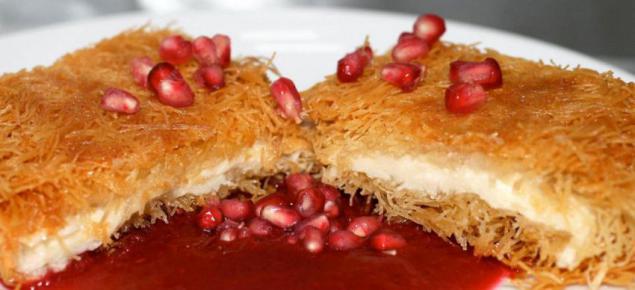
Gibney Damietta
Gibney Damietta - white soft cheese made in the city of Damietta in northern Egypt. It is usually made of buffalo milk, but sometimes added to the mixture, and cow's milk. This is the most common cheese in Egypt, added to a large number of dishes such as sambusak (thin fried pastry filled with cheese), or mesh (tomato and cheese appetizer). Gibney Damietta preserved for 1-3 years in the big banks, so that it can have. Most Egyptian families proud of the number of cans that they mothballed. The more the cheese is stored, the more it becomes a delicious taste.

Source: lifeglobe.net
Halva - Middle Eastern food, common in all the countries in the Mediterranean. Made from sesame seeds and is available in many forms: blocks, cakes, energy bars, etc. Halva is sometimes mixed with other additives to enhance the flavor. Among them: pistachios, pine nuts and almonds. Egyptians eat halva, as a snack or for breakfast and lunch. It can be used as the main component in many other dishes, such as Salakan - a mixture of halva, honey and whipped cream. It is also one of the few products that can withstand the hot Egyptian weather without decomposition, without needing any special storage conditions.

Kushari
Believes the Egyptian national dish, Kushari including rice, pasta, lentils, onions, garlic and chickpeas. The presence of four sources of carbohydrates makes it the most popular dish for lunch in most regions of Egypt for over 100 years. Interestingly, the origin Kushari not Egyptian. In fact, this dish dish was imported by the British army in the 19th century: the pasta was imported from Italy, tomatoes from Latin America and rice from Asia, but the idea is to mix it all together in one extremely delicious vegetarian dishes was conceived in Egypt. Kushari has become an integral part of the national cuisine of Egypt ever since.

Ful medames
One of the most popular dishes in Egypt, Ful medames consists of beans, served with butter, garlic and lemon juice. Ful medames can be traced back to Pharaonic roots and references were found in the twelfth dynasty. The word "Medames" has Coptic origin and translates as "buried." This relates to the way the original dish prepared: in pot buried in the hot charcoal or sand. Ful medames can be supplied with a number of additives such as oil, tomato sauce, tahini or egg. However, most traditional method - eat it just salt, with Egyptian bread bun. Nowadays it is national dishes of Egypt exported to many Middle Eastern countries such as Syria, Lebanon, Saudi Arabia and Sudan.

Fatta
Regarded as Nubian dish Fatta usually prepared for celebrations, such as the first born of women, Christian and Muslim holidays. The dish consists of layers of rice and fried bread coated with garlic cloves and vinegar. Large chunks of stewed beef and deep-fried, poached eggs are usually served along with the basis of rice and bread. As you can imagine, Fatta - really rich dish with a very high calorie. His rarely eat during the year, except for major religious days, 50 days before Easter in the Coptic Christians, or in the month of Ramadan.

Muluk
Muluk prepared from the leaves of jute and other plants that grow in the eastern and northern Africa. In Egypt muluk prepared from chopped leaves with garlic and coriander, with the addition of meat of chicken, beef, or a rabbit, and served with Egyptian bread or rice. Interestingly, various cities in Egypt are preparing the dish in different ways, for example - as the base for the broth in coastal cities such as Alexandria and Port Said, used seafood. During the end of the tenth century, the dish was banned Fatimid caliph Al-Hakim bi-Amr Allah. After the ban was lifted, some religious sects still refuse to eat the dish in respect to the late Caliph.

Fisikh
Fisikh (Feseekh) - a traditional Egyptian dish is served only during the festival of Sham El Nessim - spring celebration with Pharaonic origin. He is a gutted, salted and dried gray mullet. The preparation process includes drying fish in the sun and salt, the dish is usually prepared Fasahani specialized person. Because of the method of preparation Fisikh can cause poisoning if cooked properly. Fish is usually stored in thick glass jars, which firmly closed as exude a very pungent odor. The dish is served with Egyptian bread, cut into cubes, onions and lots of lemons.

Taro Soup
Taro - native plant of Southeast Asia, which appeared in the Mediterranean part of Egypt in ancient times. Taro soup is very popular in Egypt, and the cooking process includes cleaning taro tubers and their boiling broth with lemon juice, garlic and coriander. Once out of mashed taro, and served as a side dish with Egyptian flat bread. Taro is prepared during the Coptic Christian celebrations of Baptism and the cooking method resembles the baptism of Jesus.

Dukka
Dukka - Egyptian food, commonly used as an appetizer or side dish, along with Egyptian flat bread, or raw vegetables. This dish is a national Egyptian cuisine consists of a mixture of herbs, nuts and spices, such as salt, sesame, coriander and cumin. Dukka usually prepared at home, and every family has different additives to the recipe. It is also sold in stores spices in small paper cones. The name "Dukkah" obtained is of Arabic origin and describes how all the spices mixed together to prepare a dish. Little known outside of Egypt, received only a small popularity in Australia. But among the most popular street food world is the Egyptian falafel, widespread throughout the world.

Kunafa
Kunafa - Egyptian delicacy, made of very thin, like noodles biscuits. Origin kunafy very mysterious - his presence was recorded in medieval Arab cookbooks Egypt, the Levant and Turkey, but the exact origin has always been known. Refreshments prepared by spraying with long rows of liquid noodles on a hot plate until they become dry and harder. Then noodles mixed with butter and wrapped around the filling, made of nuts and whipped cream is placed in an oven and finally watered syrup.

Gibney Damietta
Gibney Damietta - white soft cheese made in the city of Damietta in northern Egypt. It is usually made of buffalo milk, but sometimes added to the mixture, and cow's milk. This is the most common cheese in Egypt, added to a large number of dishes such as sambusak (thin fried pastry filled with cheese), or mesh (tomato and cheese appetizer). Gibney Damietta preserved for 1-3 years in the big banks, so that it can have. Most Egyptian families proud of the number of cans that they mothballed. The more the cheese is stored, the more it becomes a delicious taste.

Source: lifeglobe.net


